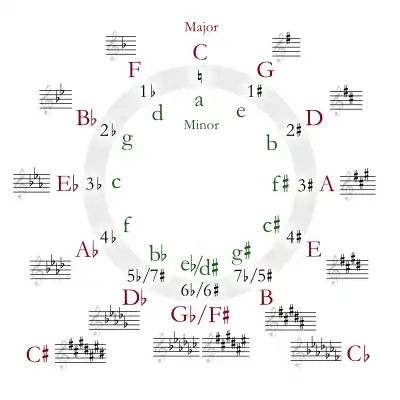B minor
B minor is a minor scale based on B, consisting of the pitches B, C♯, D, E, F♯, G, and A. Its key signature has two sharps. Its relative major is D major and its parallel major is B major.
| Relative key | D major |
|---|---|
| Parallel key | B major |
| Dominant key | F-sharp minor |
| Subdominant | E minor |
| Component pitches | |
| B, C♯, D, E, F♯, G, A | |
The B natural minor scale is:
Changes needed for the melodic and harmonic versions of the scale are written in with accidentals as necessary. The B harmonic minor and melodic minor scales are:
Christian Friedrich Daniel Schubart (1739–1791) regarded B minor as a key expressing a quiet acceptance of fate and very gentle complaint, something commentators find to be in line with Bach's use of the key in his St John Passion.[1] By the end of the Baroque era, however, conventional academic views of B minor had shifted: Composer-theorist Francesco Galeazzi (1758–1819)[2] opined that B minor was not suitable for music in good taste. Beethoven labelled a B-minor melodic idea in one of his sketchbooks as a "black key".[3]
Scale Degree Chords
- Tonic - B minor
- Supertonic - C-sharp diminished
- Mediant - D major
- Subdominant - E minor
- Dominant - F-sharp minor
- Submediant - G major
- Subtonic - A major
Notable compositions in B minor
- Johann Sebastian Bach
- Ludwig van Beethoven
- Bagatelle Op. 126/4
- Allegretto WoO 61 for piano
- Charles Auguste de Bériot
- Violin Concerto No. 2 in B Minor, Op. 32
- Alban Berg
- Piano sonata, Op. 1
- Johannes Brahms
- Ballade (Intermezzo) Op. 10/3
- Capriccio Op. 78/2
- Rhapsody Op. 79/1
- Clarinet Quintet, Op. 115
- Intermezzo Op. 119/1
- Alexander Borodin
- Symphony No. 2
- Sonata for cello and piano
- Frédéric Chopin
- Scherzo No. 1, Op. 20
- Étude, Op. 25, No. 10
- Prelude in B minor "Tolling Bells", Op. 28, No. 6
- Piano Sonata No. 3, Op. 58
- Mazurka Op. 30/2
- Mazurka, Op. 33/4
- Waltz, Op. 69, No. 2
- Gaetano Donizetti
- String Quartet No. 16
- Antonín Dvořák
- Cello Concerto, Op. 104
- Edward Elgar
- César Franck
- Johann Nepomuk Hummel
- Piano Concerto No. 3, Op. 89
- Franz Liszt
- Piano Sonata, S. 178
- Ballade No. 2, S. 171
- Wolfgang Amadeus Mozart
- Adagio, K. 540
- Niccolò Paganini
- Violin Concerto No. 2, Op. 7
- Sergei Rachmaninoff
- Moments musicaux No. 3, Op. 16
- Prelude in B minor, Op. 32, No. 10
- Études-Tableaux No. 4 in B minor, Op. 39
- Camille Saint-Saëns
- Violin Concerto No. 3, Op. 61
- Domenico Scarlatti
- 12 of his 555 piano sonatas: K 27, 87, 173, 197, 227, 293, 376, 377, 408, 409, 497, 498
- Franz Schubert
- Symphony No. 8 (Unfinished), D. 759
- Rondo in B minor for violin and piano, D. 895
- Alexander Scriabin
- Fantaisie in B minor, Op. 28
- Pyotr Ilyich Tchaikovsky
- Georg Philipp Telemann
- Fantasia for flute solo No. 3
- Fantasia for violin solo No. 9
- Sonata for two flutes or violins No. 5
- Antonio Vivaldi
- Trio Sonata Op. 1/11
- Violin Sonata, Op. 2/5
- Concerto for violin Op. 3/10
- Violin Sonata, Op. 5/4
- Violin Concerto for four violins Op. 9/12
References
Notes
- Tusa 1993, pp. 2–3, n. 5.
- Galeazzi 1817, p. .
- Tusa 1993, p. 2, n. 3.
Sources
- Galeazzi, Francesco (1817). Elementi teorico-pratici di musica con un saggio sopra l'arte di suonare il violino analizzata, ed a dimostrabili principi ridotta. Ascoli. See also Francesco Galeazzi, The Theoretical-Practical Elements of Music, Parts III and IV; English translation, with introduction and commentary, by Deborah Burton and Gregory W. Harwood (Champaign, Illinois: University of Illinois Press, 2012); ISBN 978-0-252-03708-5.
- Tusa, Michael C. (1993). "Beethoven's 'C-Minor Mood': Some Thoughts on the Structural Implications of Key Choice". In Christoph Reynolds (ed.). Beethoven Forum. Vol. 2. Lincoln: University of Nebraska Press. ISBN 978-0803239098.
External links
 Media related to B minor at Wikimedia Commons
Media related to B minor at Wikimedia Commons




